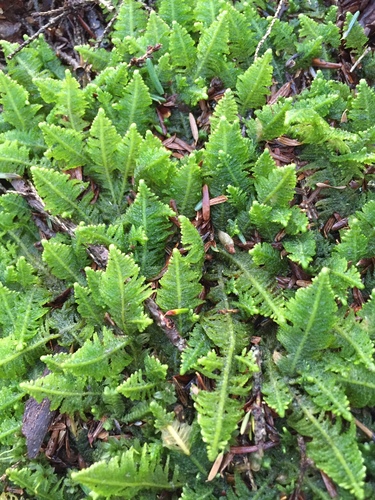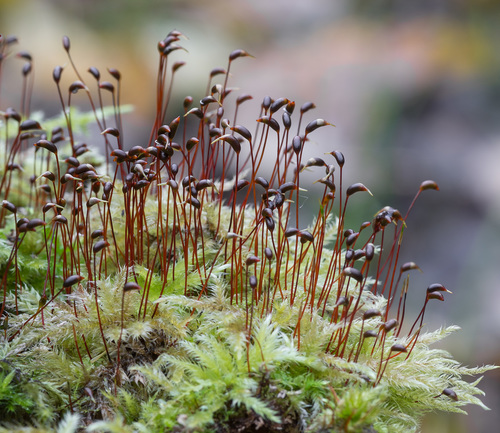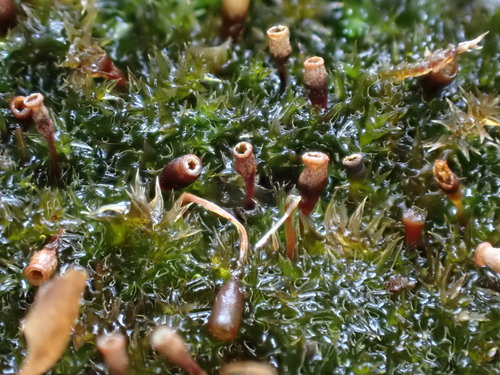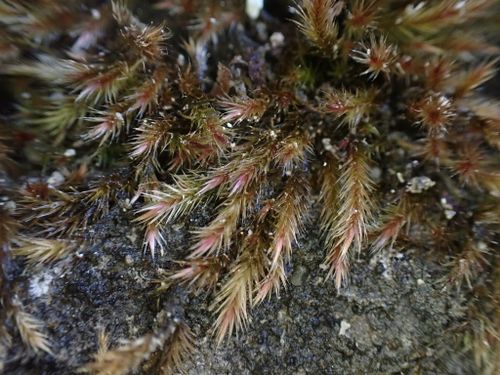Hypnaceae
Hypnum Moss Family / Feather Moss / Plait Moss Family
Hypnaceae is a very large and diverse family of pleurocarpous mosses, representing the core and type family of the order Hypnales. These mosses are cosmopolitan and found in a vast range of habitats. They typically form intricate mats or wefts, often green, yellowish, or brownish. Key characteristics frequently include falcate-secund (sickle-shaped and curved to one side) leaves, a costa that is usually short and double or absent, smooth leaf cells, a typically smooth seta, and inclined to horizontal, often curved, cylindric capsules.

Overview
The Hypnaceae family is one of the largest families of mosses, with estimates ranging widely due to ongoing taxonomic revisions, but potentially including 20-50 genera and several hundred species worldwide. Historically, it served as a large repository for many pleurocarpous mosses, but modern molecular studies have led to the segregation of numerous groups into other families (like Amblystegiaceae, Brachytheciaceae, Hylocomiaceae, Plagiotheciaceae, Sematophyllaceae). Despite this, Hypnaceae sensu stricto remains a major family.
Members of Hypnaceae are ubiquitous, colonizing diverse substrates such as soil, humus, decaying wood, rocks, tree bases, and walls, across habitats ranging from forests and woodlands to bogs, tundra, grasslands, and disturbed areas. They typically form interwoven mats or wefts. A common, though not universal, feature is the tendency for leaves to be falcate-secund, curving downwards or to one side like the blade of a sickle. The costa is characteristically weak, usually short and double or completely absent. The capsules, borne on typically smooth setae, are generally cylindrical and curved.
Ecologically, Hypnaceae species play significant roles in various ecosystems as ground cover, contributing to soil moisture retention and providing microhabitats. Some species are very common and adaptable. As the type family of Hypnales, it is central to understanding the evolution and diversity of the largest order of mosses.
Quick Facts
- Scientific Name: Hypnaceae
- Common Name: Hypnum Moss Family, Feather Moss Family, Plait Moss Family
- Number of Genera: Approximately 20-50 (variable circumscription)
- Number of Species: Approximately 300-600 (variable circumscription)
- Distribution: Cosmopolitan.
- Habitat: Extremely varied: soil, humus, logs, rocks, tree bases, walls, wetlands, tundra, etc.
- Evolutionary Group: Bryophytes - Mosses (Class: Bryopsida, Order: Hypnales)
Key Characteristics
Growth Form and Habit
Plants are pleurocarpous, typically forming intricate, interwoven mats or wefts, sometimes pendent. Size ranges from small to relatively large. Branching is usually irregular to somewhat pinnate.
Stems
Stems creeping or ascending, often freely branched. Paraphyllia are generally absent. Pseudoparaphyllia may be present or absent.
Leaves
Leaves are typically crowded, often falcate-secund (curved like a sickle and pointing to one side), but can also be straight or slightly curved. Shape is commonly lanceolate to ovate-lanceolate, usually gradually tapering to an acuminate apex. Leaves are typically not strongly plicate (folded). Crucially, the costa is short and double, or absent (ecostate). Leaf margins are often entire or serrulate towards the apex. Leaf cells are typically linear to rhomboidal, smooth (not papillose). Alar cells at the basal corners are often differentiated, sometimes forming distinct groups of quadrate, colored, or slightly inflated cells, but usually not large hyaline auricles.
Asexual Reproduction
Asexual reproduction via specialized propagules (gemmae, deciduous branchlets) occurs in some genera but is not widespread across the family.
Sporophytes (Reproductive Structures)
Sporophytes arise laterally. The capsule is elevated on a long, typically smooth seta (though rarely slightly roughened). The capsule is generally cylindric (sometimes ovoid-cylindric), usually inclined to horizontal, and often distinctly curved and asymmetric. The capsule wall is smooth. The peristome is double (diplolepidous), well-developed, and of the typical Hypnalean type, with 16 outer teeth and 16 inner segments often bearing cilia. The operculum (lid) is usually conic to rostrate.
Habitat
Found in an extremely wide range of habitats worldwide, including forests (on various substrates), woodlands, swamps, bogs, tundra, grasslands, lawns, rocks, walls, and disturbed ground. Very adaptable.
Field Identification
Identifying Hypnaceae often involves recognizing the pleurocarpous habit, the frequently falcate-secund leaves, the lack of a strong single costa, and the typical capsule shape and smooth seta.
Primary Identification Features
- Growth Habit: Pleurocarpous, forming mats or wefts.
- Leaf Orientation (Common Feature): Leaves often falcate-secund (sickle-shaped, curved to one side).
- Costa (Key Feature): Costa short and double, or absent.
- Seta Texture (Key Feature): Seta typically smooth.
- Capsule Shape/Orientation: Capsule typically cylindric, inclined to horizontal, often curved.
- Paraphyllia: Generally absent from stems.
Secondary Identification Features
- Leaf Cells (Microscopic): Typically linear, smooth.
- Alar Cells: Often somewhat differentiated, but usually not forming large auricles.
- Leaves: Usually not strongly plicate.
Seasonal Identification Tips
- Year-round: The vegetative mats are visible year-round. Falcate-secund leaves are a persistent feature.
- Sporophyte Timing: Sporophytes are common in many species and can mature at various times, often spring or summer. The smooth seta and curved, inclined capsule are key features when present.
Common Confusion Points
Hypnaceae can be confused with numerous other pleurocarpous families, especially within Hypnales:
- Brachytheciaceae: Have a single costa ending mid-leaf or higher, leaves often plicate, seta often rough.
- Amblystegiaceae / Calliergonaceae: Often have a single costa (though sometimes short/double), often distinct inflated alar cells/auricles, typically wetter habitats.
- Hylocomiaceae: More robust, regularly pinnate/bipinnate branching, often red stems, paraphyllia often present.
- Plagiotheciaceae: Often complanate (flattened) shoots, leaves often decurrent and asymmetric.
- Sematophyllaceae: Often have strongly differentiated, inflated alar cells, peristome details differ.
- Thuidiaceae: Regularly pinnate branching, abundant paraphyllia present.
Look for the combination of pleurocarpous habit, often falcate-secund leaves, costa short/double or absent, and smooth seta with inclined, curved, cylindric capsule.
Field Guide Quick Reference
Look For:
- Pleurocarpous mats/wefts
- Leaves often falcate-secund
- Costa short & double, or absent (Key!)
- Paraphyllia absent
- Seta typically smooth
- Capsule cylindric, inclined/horizontal, often curved
Key Variations:
- Degree of leaf curvature (falcate vs. straight)
- Branching pattern (irregular vs. pinnate)
- Alar cell development
- Plant size and color
Notable Examples
This very large family includes many common and widespread mosses:

Hypnum cupressiforme
Cypress-leaved Plait-moss
An extremely common and highly variable species found worldwide on diverse substrates (trees, rocks, soil, walls). Typically forms dense, green to yellowish-brown mats. Leaves strongly falcate-secund, lanceolate, ecostate or with very short double costa. Capsules common, cylindric, curved, on reddish smooth setae.

Ptilium crista-castrensis
Ostrich-plume Feather-moss / Knight's Plume Moss
A beautiful moss forming elegant, pale green to yellowish, regularly pinnate 'plumes' resembling ostrich feathers. Found on humus and logs in coniferous forests. Leaves strongly falcate-secund with long points. Costa short/double or absent. Capsules rare.

Calliergonella cuspidata
Pointed Spear-moss / Pointed Bog-moss
(Sometimes placed in Amblystegiaceae/Calliergonaceae). Very common in wet lawns, marshes, fens, ditches. Forms green to yellowish mats with distinctive cuspidate (sharply pointed) shoot and branch tips formed by rolled-up young leaves. Leaves ovate, concave, ecostate. Capsules infrequent.

Ctenidium molluscum
Comb Moss / Delicate Fern Moss
Forms neat, yellowish-green to golden-brown, densely and regularly pinnate mats, often on calcareous soil or rock in woodlands or grasslands. Leaves strongly falcate-secund, plicate at base. Costa short/double or absent. Resembles a fine comb or fern frond.
Phylogeny and Classification
Hypnaceae is the type family for the order Hypnales, the largest order of mosses, encompassing the majority of pleurocarpous species. Situated within the class Bryopsida and subclass Bryidae, Hypnaceae historically represented a vast, polyphyletic assemblage.
Modern molecular phylogenetics has significantly reshaped the understanding of Hypnaceae and Hypnales. Many genera previously included in Hypnaceae have been transferred to other families (e.g., Amblystegiaceae, Brachytheciaceae, Sematophyllaceae, Plagiotheciaceae, Hylocomiaceae), resulting in a more narrowly defined, but still large and diverse, Hypnaceae sensu stricto. The family remains central to the Hypnales order, representing a major evolutionary radiation of pleurocarpous mosses.
Position in Plant Phylogeny
- Kingdom: Plantae
- Division: Bryophyta (Mosses)
- Class: Bryopsida
- Subclass: Bryidae
- Order: Hypnales
- Family: Hypnaceae
Evolutionary Significance
Hypnaceae is highly significant in bryophyte evolution:
- Core of Hypnales: Represents a central part of the largest and arguably most successful evolutionary radiation of mosses (pleurocarpy).
- Ecological Dominance: Includes species that are dominant ground cover in many ecosystems worldwide.
- Morphological Diversity: Despite core features, shows considerable variation in habit, leaf shape, and adaptation to diverse environments.
- Taxonomic History: Its changing circumscription reflects the progress and challenges in understanding moss phylogeny using molecular data.
- Adaptability: Contains highly adaptable and weedy species (Hypnum cupressiforme) alongside specialists (Ptilium).



